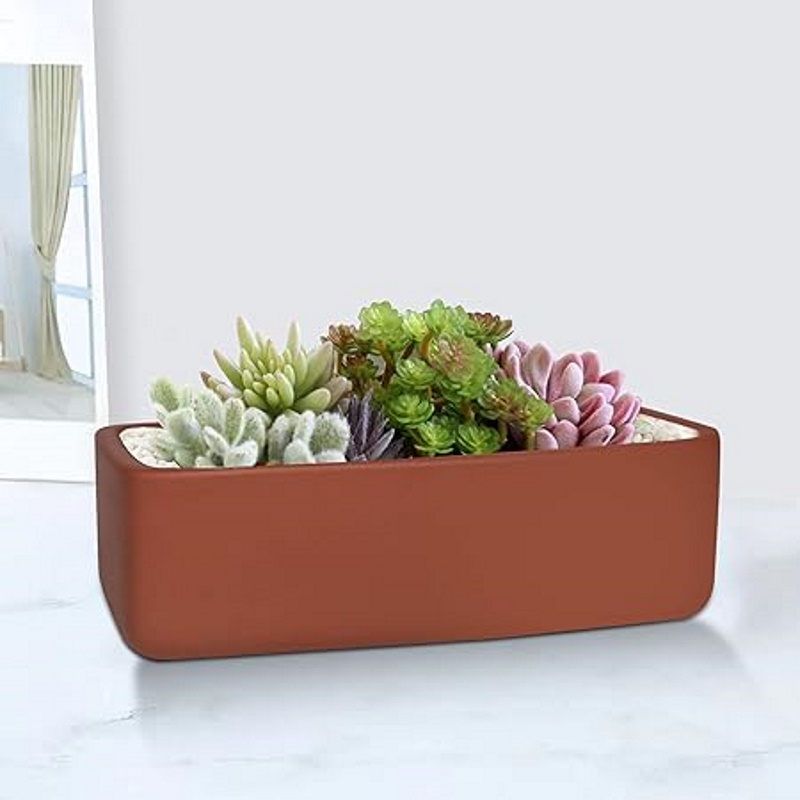Should you use terracotta indoor planters? Here's why I think they're the best pots for indoor gardening
Terracotta pots are breathable containers that can help keep your indoor plants happy


When you're a lover of indoor plants like me, you take pride in your houseplant display and a big part of how you style your style houseplants is choosing which containers to home them in.
There's a lot to be said about terracotta planters - their breathable nature have made them a reliable staple in container gardening. But have you ever considered using them indoors? It previously never crossed my mind to use terracotta indoor planters, purely for the fact I didn't think it would fit in with my interior aesthetic, but those dark orange hues actually add a rustic charm. After realising how beneficial terracotta pots are to houseplants, I'll never look back.
I've gathered expert advice to find out more about why terracotta indoor planters are beneficial to the health of our houseplants - plus the best terracotta indoor planters on the market.

Why use terracotta indoor pots?
Terracotta pots have long been loved by gardeners for their breathable nature. While they have always been in popularity for outdoor patios and container gardens, not as many plant lovers opt for them indoors. I've spoken to experts to find out why we should be using terracotta indoor planters for happy and healthy houseplants.
Better water drainage

One of the main reasons terracotta planters are used is because they help monitor moisture levels and water houseplants correctly.
'Houseplants can do well in terracotta pots,' says Sally Allsop, founder of All That Grows. 'Terracotta pots reduce the risk of overwatering your plants as they allow excess moisture to evaporate through the walls of the pot. This can help reduce the risk of houseplant root rot and fungal diseases,' she adds.
This is one of the main reasons I decided to try terracotta indoor planters. It's really easy to overwater houseplants, in fact its one of the most common indoor plant mistakes. I found that my plants that were previously holding onto too much moisture in soil were now drying out in a terracotta planter.
Design expertise in your inbox – from inspiring decorating ideas and beautiful celebrity homes to practical gardening advice and shopping round-ups.
Terracotta is efficient at managing water levels of plants because it is made from a porous clay which allows moisture to be released more easily than a pot made from plastic, for example, which may lock moisture in.
This also makes terracotta indoor planters a great option for watering plants while on vacation because it will ensure your plants soak up as much moisture they need and don't sit in waterlogged soil.
'The porous nature of terracotta also allows for better aeration, ensuring that plant roots receive sufficient oxygen for healthy growth,' says Sally.

Sally is an avid gardener and founder of the online gardening site All That Grows. She has many years of hands-on gardening experience and a thirst of knowledge about plants and their needs. Sally is passionate about sharing her love for gardening and sharing tips with other gardeners.
Better insulation

If you have an indoor herb garden, want to propagate the easiest houseplants to grow from cuttings or plan to sow seeds indoors, terracotta indoor planters can help promote growth.
'Terracotta pots naturally insulate plant roots from extreme temperatures,' says Sally. 'Outdoors they keep roots cooler in hot weather and warmer in colder climates,' she adds.
'This is less of an issue for indoor plants, but even so, they can suffer from cold and warm temperatures depending on where they are kept in the home,' she says.
I found that my propagation cuttings benefited hugely by growing in terracotta pots a warm, sunny windowsill. The warmth was retained by the pots, providing optimal conditions for cuttings to root. Seeds sown indoors will likewise appreciate the insulation and germination will be encouraged.
Overall, I have found that terracotta indoor planters have qualities that make it easier to manage the health of houseplants.
Best terracotta indoor pots
Not only are terracotta indoor planters beneficial for the care and health of your houseplants, they are also beautiful additions to your home. There are so many terracotta indoor planters available, in many shapes, sizes and patterns to fulfil different aesthetics and needs of plants. Here are our top picks.
FAQs
Which houseplants can go in terracotta pots?
Terracotta indoor planters are great for houseplants. They are extremely breathable and allow soil to drain well. Most houseplants will do well in terracotta plants, especially those that don't like sitting in waterlogged soil. This includes calatheas, orchids and monsteras to name a few. Although, you should avoid placing plants that enjoy consistently moist soil in terracotta planters as they may dry out too quickly, such as ferns.
Once you realise how beneficial terracotta indoor planters are to your houseplants, it can change the way you look after your indoor garden. If you enjoy using terracotta planters in your backyard, take care to keep on top of cleaning your terracotta pots to keep them fresh and prevent harmful bacteria entering the porous material.

Tenielle is a Gardens Content Editor at Homes & Gardens. She holds a qualification in MA Magazine Journalism and has over six years of journalistic experience. Before coming to Homes & Gardens, Tenielle was in the editorial department at the Royal Horticultural Society and worked on The Garden magazine. As our in-house houseplant expert, Tenielle writes on a range of solutions to houseplant problems, as well as other 'how to' guides, inspiring garden projects, and the latest gardening news. When she isn't writing, Tenielle can be found propagating her ever-growing collection of indoor plants, helping others overcome common houseplant pests and diseases, volunteering at a local gardening club, and attending gardening workshops, like a composting masterclass.





